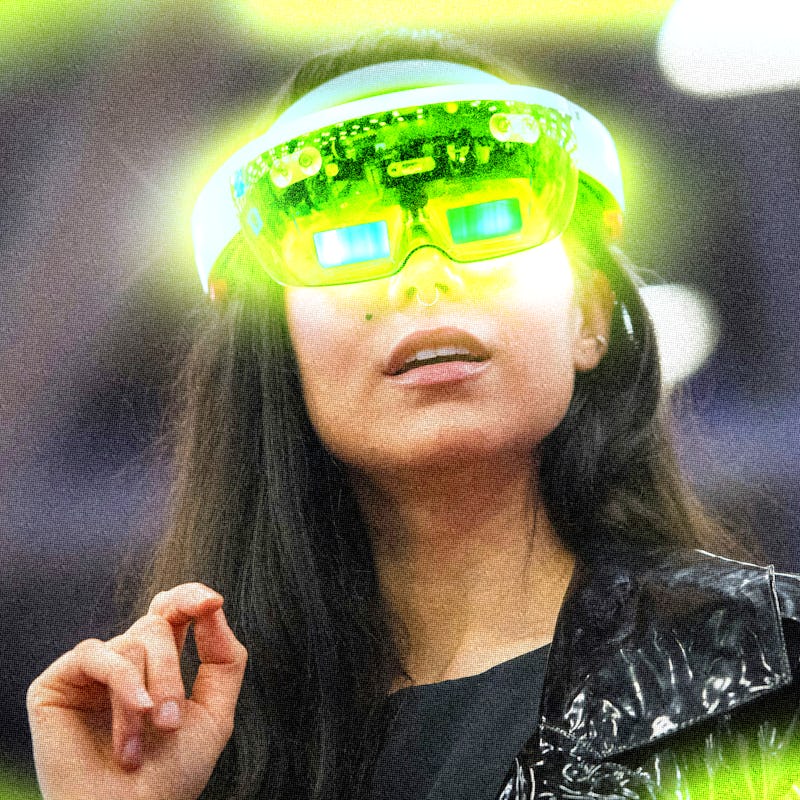8 Years Ago, Microsoft’s AR Headset Flopped So the Vision Pro Could Soar
The HoloLens never made it to consumers and never became the AR headset Microsoft imagined, but its ideas are still alive in modern headsets like the Vision Pro.

Proper augmented reality is years, if not decades away. Not necessarily because we don’t have the software know-how or display technology to make it happen, but because it’s not possible to do it well or affordably in 2024.
That hasn't stopped companies from making real, functional AR their goal, but it does mean what’s been released isn’t exactly up to snuff. Microsoft's HoloLens, an augmented and mixed reality headset that aimed to realize a new kind of computing in the shadow of Windows 10 wasn't able to succeed. Because of limitations and more than one scandal, it's been stuck as an expensive enterprise tool for years, but that doesn't mean it wasn't important.
In the eight years since Microsoft released the HoloLens Development Edition, the idea for how a truly "spatial" computer should operate has been cemented and, despite all of its awkwardness, the HoloLens laid the groundwork for devices like the Vision Pro and whatever else comes after.
Windows 10 You Can Wear
The HoloLens was introduced in January 2015 as a truly revolutionary device that combined the tech Microsoft experimented with in its Kinect device — an AR camera designed for the Xbox — with a very different implementation of Windows 10.
Microsoft’s headset used cameras, accelerometers, magnetometers, gyroscopes, 3D speakers, and waveguide displays to track your head and hand movements and create the illusion of holograms floating, sitting, and pinned in the world around you. The first generation version used an Intel Cherry Trail chip running Windows 10 and a Microsoft-designed Holographic Processing Unit coprocessor to help out mapping rooms and recognizing hand gestures
While Microsoft imagined plenty of productivity use cases for the HoloLens, like creating and viewing 3D models or taking Skype calls, the original HoloLens was also pitched as an entertainment device. Microsoft’s “Building Blocks” demo was essentially Minecraft’s Creative Mode mapped onto the room around you. RoboRaid had robots bursting into the room around you that you could shoot at (every headset gets a demo like this eventually). Even Asobo Studio, best known now for the Plague Tale series and the modern Microsoft Flight Simulator, developed multiple experiences for the original HoloLens.
The HoloLens Development Edition was sold for $3,000, which kept it firmly in the world of developers and enthusiasts willing to tinker, but Microsoft released an augmented reality device that might actually work as a real computer well before its competitors.
Displays and Other Issues
Microsoft’s custom military headset were more than a little controversial.
That’s if you ignore the glaring issue at the heart of the HoloLens: It could only create its holograms in a small floating square as opposed to your entire field of view. According to a Tom’s Hardware hands-on from 2015, “unlike a wraparound VR environment that's designed to be immersive, the HoloLens display is a smallish rectangle — sort of like a TV screen sitting within your field of view.” That’s not the experience Microsoft’s concept videos sold. Being able to see, “where the magic holograph world ends and your peripheral vision begins,” as The Verge described it, broke the illusion the headset was trying to create in the first place.
Microsoft expanded that field of view with the HoloLens 2, from the original 34 degrees to 52 degrees, but the images the current HoloLens 2 produces (fully as an enterprise device at this point) are far from the resolution you’d want from a virtual display and objects you’re meant to be staring at for large portions of the day. In some cases, it’s enough to make users sick.
A flashpoint for the HoloLens was a $21.9 billion deal Microsoft cooked up to supply custom HoloLens headsets to the US military. Employees were against the idea of Microsoft profiting off of war. A report from Business Insider suggested early trials were a problem, too, with the headsets limiting peripheral vision, adding extra bulk, and giving away the location of anyone who wore them because of the glow of waveguide displays. Those issues would eventually get ironed out, but it’s a good expression of just how confusing Microsoft’s mixed reality strategy was, culminating in the shutdown of AltspaceVR cuts across the company’s augmented and virtual reality teams, and the recent pivot to consumer AI.
Pinching Floating Windows
And yet, even if the HoloLens is a shadow of itself, it’s hard to deny how many ideas it arrived at first that Apple is now pushing on the Vision Pro. While Apple’s headset doesn’t use clear displays like the HoloLens, it is trying to recreate the experience of floating and spatially aware digital interfaces. It’s also similarly reliant on pinching as an input gesture, something the Vision Pro makes far more seamless with eye-tracking. Even the prices, with the original HoloLens coming in at $3,000 and the Vision Pro starting at $3,500, are similar.
What’s changed in the eight years since the HoloLens is really companies’ ambitions, and the understanding that the technology just isn’t there yet. It doesn’t necessarily make Apple’s or Meta’s approach better, but it does make them more consumer-friendly. Ultimately, Microsoft jumped the gun, pushing an XR headset before “The Metaverse” was a buzzword and before technology could turn marketing images into a fully usable reality. Are Meta, Apple, or even Samsung committed in a way Microsoft wasn’t? I’m not sure, but they are here now.